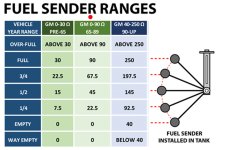Are you sure you received the correct sending unit and also if is not defective ?
I doubt something in the tank is broken and preventing float to move
Float sends out a resistance value depending on the gas level in tank, look at where
I put the red dot
As example if the gas level was 3/4 full then the output wire of float would measure 67.5 OHMs

That resistance value is sent to the fuel gauge on the dash
Follow this to debug if problem is in tank, sender wrong type of defective or the gauge
You need to measure the resistance of the fuel sender.
It’s easy, the most important thing you need to remember is the sending unit
wire cannot be connected to the gas gauge.
You can measure the resistance either at the sending unit directly or at the gauge (disconnected) by probing the fuel sender wire at the dash.
STEP 1: Set your multimeter to OHMs (O).
Keep it on auto or in the <200 O range if a selection range is available on your unit. You don’t need an expensive multimeter to perform this test.
STEP 2: Ground one of the multimeter probes somewhere on the
vehicle chassis/body/tank.
Don’t forget, your sender needs to be grounded too!
We like to use some alligator clips to hold the probe in place or use as a jumper for hands-free working.
STEP 3: Probe the sender wire with the other end of the multimeter.
This will display a number in OHMs (O).
If you have another set of alligator clips, these come in handy, especially when you are under the dash. Write down this OHMs value.
STEP 4: Here’s the trick to this. If you can approximate the amount of fuel you have in the tank, that will tell you which sender you have.
There are two ways to do this:
- If the sender is out of the tank, all you need to do is move the float up and down while measuring the resistance (ohms). That will tell you the whole story of which sender you have.
- If the sender is in the tank and installed in the vehicle, we do have a workaround for that too. Our techs at New Vintage USA get this call either when installing the gauges or after the customer has run out of gas. To figure this out we need to know two things:
A. How much fuel is in the tank?
B. What is the resistance (O) of the fuel sender?
Here are some ways to figure out your sender while it's in the tank:
-Check the resistance (ohms) when it's full:
Easiest method -Check the resistance when the tank is empty:
Easy on a new tank before it's full -If you know how much fuel is in the tank, use the chart to see the resistance,
BUT this only works with one of the previous two measurements

